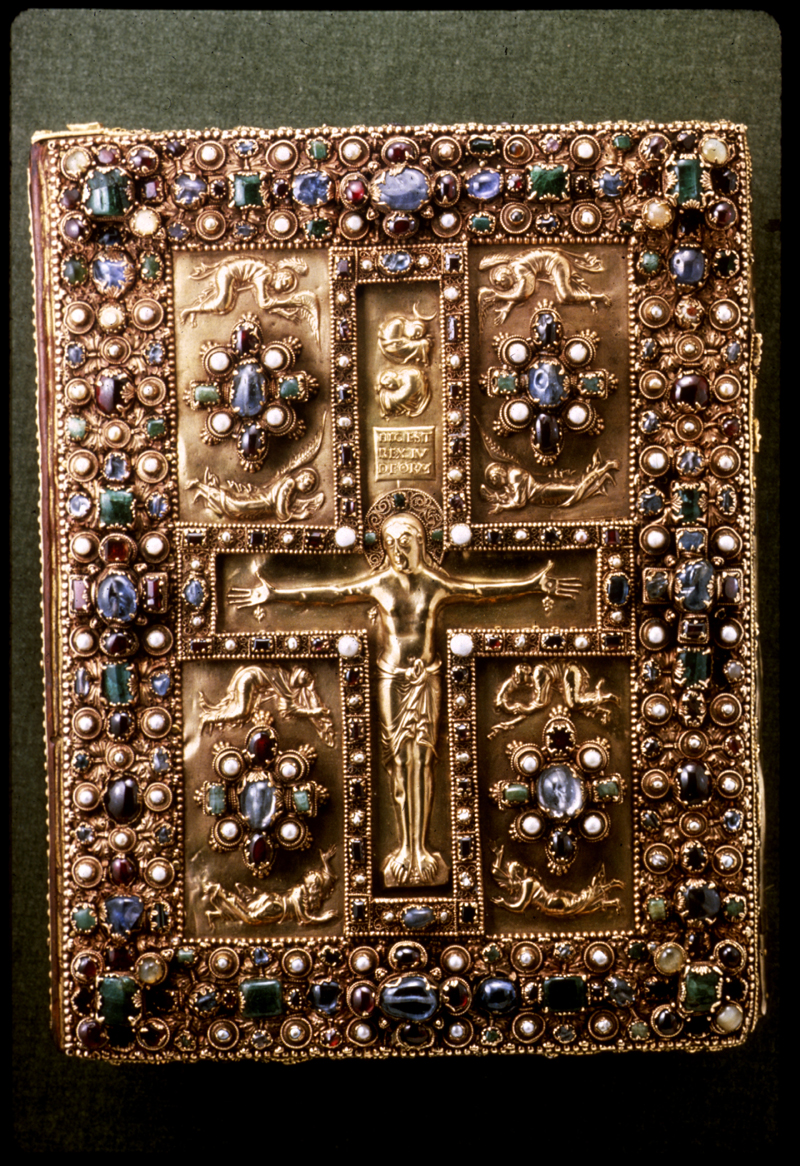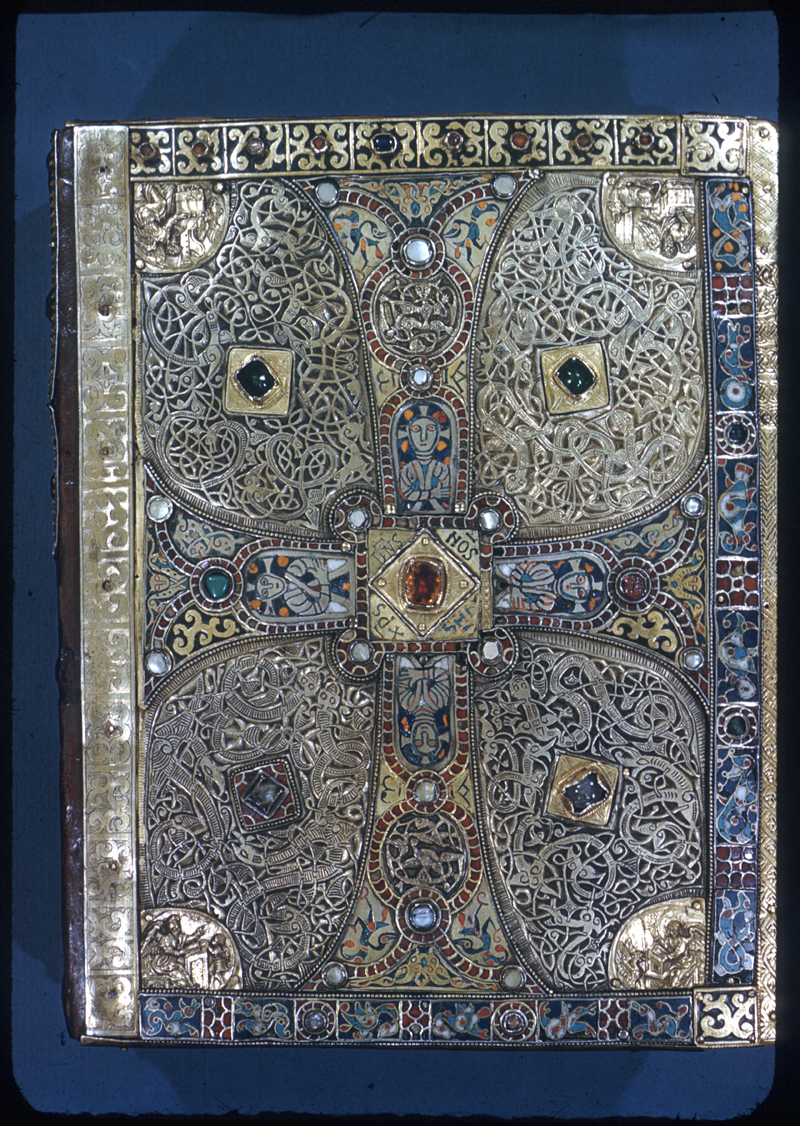Essay on Joan
Lindau Gospel
Images of the Maid
Links
Home

Lindau Gospel Book Cover
The Lindau Gospel Book Cover is a signatory representative of the early and mid 9th century due to its quality to compel and garner
admiration from the common masses. The cover exemplifies the attributes of many other works from its period. It is a safe assumption
that the majority of the citizens that lived during the time these works were created couldn’t read, and that works of art such as the book cover could function
as a metaphor for the story contained within. Stories like the Passion could be depicted on a slab of stone or pressed into a sheet of gold to show
levels of importance on particular moments.
One example of a multi-level drawing is that of the Utrecht Psalter. The Psalter, created around 820 in Reims, is a preliminary
source for the style of metaphor overlaid in visual representation1. The Psalter provided an interpretation to all of the Biblical allusions, sometimes
very cleverly. Though
the type of visual representation found in the Psalter are thought to be modeled after earlier forms2 there is a certain simplicity in style that seems
to compel not the courtesans, but the common citizen3 . The images are highly stylized, a far cry from the art of the aristocracy; even more telling,
it was rendered in the very local artistic style of the workshops of Reims4. The drawings are impressionistic5 and worked as a puzzle for the viewer6. There
was a definite link reaching out from the work to the viewer, the Psalter served as a prototypical way of engaging the audience in a visual tale while
communicating the literal story behind it7. The viewer was able to take a mental picture of a liturgical event8.
This style progressed and found its way to other visual forms9. The ivory book covers illustrating Psalms 50 and 51 had drawn influence and may have
been in fact directly modeled after the Utrecht Psalter10. The ivories depict the same scenes from the Psalms drawn into the Utrecht Psalter, however,
the ivory panels are more of an abridged version11. The progression from drawing to book covers represents a certain leap in audience and visual structure
even if just momentarily or inadvertently, since ivory was a luxury few could afford, and the meticulous undercutting even fewer12. The scenes did
however grow in leaps and bounds in the method of figural representation, realistic drapery, and depth that is monumentally achieved in such a minimal space13.
At this point there is a start of a certain pattern; the visual interpretations of liturgical documents expanded into larger and more luxurious mediums.
One could argue that this would achieve the precise opposite of one of the intended or inadvertent purposes of the Utrecht Psalter; in essence
neglecting those that made the style popular, the common masses. However, this could not be the case when the Lindau Gospel book cover is taken into
account.
The covers to the Codex Aureus were created in around 870 in Reims14. One strikingly similar attribute to the Lindau cover is the style in which
the figures are rendered likening it very closely to the impressionistic forms of the earlier Utrecht Psalter15. There is an attempt by the artists
to
further distance
themselves from the aristocratic realism that was found in the ivory book covers in favor of symbolic imagery16. The Lindau cover depicts Christ,
seemingly floating in an ethereal sea of unparalleled wealth, seemingly dismissing any cover rendered before it. What further separates this piece
as one of
being one of unequalled importance is the fact that it did not belong to a wealthy aristocrat or courtesan, it was created for the procession,
for the
church
going masses to look at with awe17. This work was meant to sit at the altar18, with its precious stones, pearls, and gold, one could see how it
served as a metaphor for the text within. The jewels on the cover are held in by intricate bezels, harnessing the stone in ornate and dramatic patterns
of
gold metalwork. The Repousse technique is used to render the image of Christ, the angels in mourning hovering in the heavens19, and the figures
of Mary and
John mourning below. The iconography20 is hard to ignore; the figure of Christ is rendered in gold, the book itself is rendered in jewels and ivory,
how could this not be seen as idolatry? This is where the interpretation of metaphor comes into play: the book itself was not meant to be worshipped,
but
respected as words of unparalleled importance. Like the Utrecht Psalter, the image of Christ told a compact liturgical tale in visual form. It
showed a triumphant Christ, his musculature intact, a determined spirit in his face; he isn’t dead, he is ascending the realm of reality and
entering that of the spiritual21. This is once again a reach forward to the impressionistic metaphor, reflecting the content in the form.
The Lindau Gospel book covers were in some ways a pinnacle of achievement with regard to the simplistic styles hearkening the admiration the common
citizen found in the Utrecht Psalter; it was a liturgical chapter, rendered visually in a stunning medium. The story was easily captured in a
way that words could not have implied; the idea of the triumphant Christ is an interpretation decided upon by the artist and so visually ingrained
in
those who
patronized the church that the Lindau Gospel books were a part of. Was this a way of influencing how those church goers understood the events
depicted in the Gospels? One can certainly imagine the effect something of this magnitude would have on those who couldn’t read or understand
Latin. It is a strong possibility that the covers themselves carried the faith of many who saw it and found that anything of such beauty and wealth
could simply
not be wrong.
1Beckwith, pg. 44
2Schapiro, pg. 74
3Hauser, pg. 140
4Hauser, pg. 140
5Hauser, pg. 140
6Finnegan, pg. 163
7Finnegan, pg. 163
8Finnegan, pg. 163
9Beckwith, pg. 47
10McKitterick, pg. 311
11Beckwith, pg. 47
12Beckwith, pg. 48
13Beckwith, pg. 48
14Beckwith, pg. 50
15Beckwith, pg. 50
16Cole, pg. 38
17Jeep, pg. 95
18Kibler, pg. 174
19Cole, pg. 38
20Jeep, pg. 95
21Cole, pg. 38
The Social History of Art, Volume 1: From Prehistoric Times to the Middle Ages by Arnold Hauser, Jonathan Harris (Paperback - April 1999)
Communicating: The Multiple Modes of Human Interconnection by Ruth Finnegan (Hardcover - September 2002)
The Uses of Literacy in Early Medieval Europe by Rosamond McKitterick (Editor) (Paperback - May 1992)
ART OF THE WESTERN WORLD: FROM ANCIENT GREECE TO POST MODERNISM by Bruce Cole, et al (Paperback - December 1991)
Medieval Germany: An Encyclopedia (Routledge Encyclopedias of the Middle Ages) by John M. Jeep
(Medieval France : An Encyclopedia (Garland Encyclopedias of the Middle Ages) by William W. Kibler (Editor), et al (Library Binding - March 1995)Editor) (Library Binding - January 2001)
